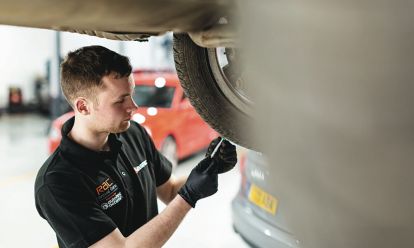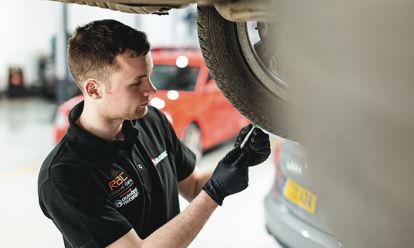Throughout the year, you may come across a few issues with your car that will need to be resolved. The safety of your vehicle is a key part to daily life, and so staying on top of any potential hazards is important.
This guide looks into MOT advisories, car maintenance, and the best practices for saving money and staying safe on the roads.
What is an MOT?
If your car is more than three years old, then you will need to take the annual Ministry of Transport (MOT) test to ensure that your vehicle is road legal and safe.
A mechanic will carry out an extensive test of all the major components in your vehicle and should they all be in working order, you will receive a test certificate which allows your to legally drive for a year.
Sometimes you may fail, and further repairs or replacements will need to be paid for before your car is in working order.
You can’t drive on UK roads without a valid MOT certificate.
This MOT checklist and comprehensive guide can give you all the information you need to prepare for the annual event.
Although your vehicle may pass its test, it is not a guarantee that before your next visit to the garage for the next MOT you will face some issues with your vehicle.
What is an MOT advisory?
Sometimes when you pass your annual MOT you will be given a list of small or potential problems that should get looked out as soon as possible – but you can legally drive without addressing them – these are advisories.
The UK has one of the world’s most extensive vehicle safety tests in the world and there are many ways in which you can fail an MOT. Advisories are defects that do not constitute a failed MOT.
MOTs are separated into three categories: Dangerous, Major, and Minor.
If your car has any Dangerous or Major faults, then it will result in a failed MOT – and you will need to address the problem before you will be allowed behind the wheel.
If your car has less serious faults, these can be classed as Minor. This is where there’s a defect on the vehicle – but it is not serious enough for the vehicle to fail the test.
Following these three categories, there is an advisories section on your MOT certificate.
These are summarised as a list of small issues that could develop into one of the three categories before your next MOT.
The MOT examiner will explain to you what they are and will offer guidance on the best course of action.
Although you can legally drive, you should not ignore these – as they could lead to a future fail, or a serious accident should the fault deteriorate.
A mechanic’s job is to help pre-empt any work that could come at a later date – and for a larger cost.
Our advice would be to address the issue immediately as it will give you peace of mind that your vehicle is road legal and as safe as possible.
Does having an advisory mean a failed MOT?
No. You can continue to drive after a passed MOT test if you have advisories.
However, you should address them as soon as possible.
This will save you money and ensure safety for all.
Common MOT advisories
Although there are potentially dozens of advisories that a mechanic can give someone’s vehicle – these are the most likely ones you will see on your next MOT certificate.
Tyres tread and health – This is by far the most common MOT advisory for drivers in the UK. Tyre tread depth is important for road safety – especially in wintery conditions. If your tyres are cracked or damaged, then it is important to address this problem immediately.
Brake pads – Over time, these will start to wear out and lose their effectiveness when you apply the brakes on your vehicle. Often a mechanic will give an estimation on the amount of time or miles left until they need to be replaced. This is because when the lining starts to erode, it will affect braking efficiency and can be dangerous. A brake pads average lifespan is about 50,000 miles.
Lights – Every vehicle has lights that are important for a variety of reasons. If some have blown, started to dimmer or have been a part of an electric fault, then they will need to be replaced. Sometimes a mechanic will suggest you replace them if they have been used for a long time. This ensures that they will not stop working when you are out on the road. Knowing how to check your lights and bulbs throughout the year can help you avoid fines from the police.
Corrosion – If your car has rust, then do not be alarmed. Although there is no immediate danger to your vehicle, it is important to address the issue before it develops into something more serious. If you have ‘surface’ or ‘scale’ rust this isn’t an immediate concern. However, if your rust starts to penetrate the surface of the vehicle then it could spread to integral parts of the vehicle.
General wear and tear – Throughout the year, you may have suffered from a few bumps, dents, or scratches to your vehicle. Although these are not an immediate problem, should they lead to parts falling off or degrading to cause internal damage, then it can make your vehicle unsafe.
Service, repair or MOT?
You can trust the RAC with our local approved garages and NEW mobile mechanics.


What to do with an MOT advisory?
MOT advisories serve as an early warning that something will become an MOT fail in the future – or perhaps before the end of your most recent certificate.
Although these will usually develop by the time the next MOT rolls around, it is important to address them as soon as you are able to.
Sometimes an MOT and the subsequent repairs can be expensive, so you may not be able to sort them out immediately. However, when you can, get them looked at as soon as possible.
If you work through your advisories while they are minor faults, then you will save money in the long run – and keep your vehicle in the best condition possible.
How to treat common MOT advisories
Ahead of your next MOT, it is worth checking what your past advisories were, and see what you can do to help.
The annual MOT doesn’t need to be a large annual expense, as long as you stay on top of the upkeep of your vehicle.
These regular car maintenance checks will help you save money and remain safe on the roads. These will make your car last longer.
When it comes to the most common MOT advisories – there are a few simple ways to deal with them.
Tyre health is the most regular issue that mechanics come across with the annual test. If there is a problem with the tread, or it is damaged, get it replaced as soon as possible.
For brake pads – or anything relating to the brakes – speak to a mechanic on how long a life your current set has left. If you drive regularly, then get them replaced when necessary.
Also, replace any broken/damaged parts, and regularly check for rust.
MOT checker
If you are interested in buying a used car, then it is important to know the vehicle’s history.
The quickest and simplest way to do this is to use the Government’s MOT History Tool.
You can check the past results of a vehicle’s MOT tests, including: if it passed or failed, the mileage recorded when it was tested, where each test was done, what parts failed at each test, and if any parts had minor problems, or when its next MOT is due.
You can only get results for tests done in England, Scotland, or Wales since 2005.
However, before you start, you’ll need the vehicle’s registration number and the 11-digit number from the vehicle’s logbook (V5C).
MOT codes
When your vehicle takes its annual MOT test, you will notice some codes alongside any failures or advisories. These are split into eleven different categories.
Section 0. Identification of the vehicle
This simply relates to the registration plates and vehicle identification number.
Section 1: Brakes
A common reason for a failed MOT or advisory, this section covers the pedal, lever pivot, air/vacuum systems, pressure/fluids, valves, hydraulic system, and level of control.
Section 2: Steering
A mechanic will check the steering wheel and column. They will also check the power steering, and condition of the steering gear.
Section 3: Visibility
This section relates to all widows, mirrors, windscreen wipers, and the washer system.
Section 4: Lamps, reflectors, and electrical equipment
Bulbs and lights are important to vehicle safety, and his section covers everything relating to this. It also covers all electrical systems.
Section 5: Axles, wheels, tyres, and suspension
This coves everything relating to the wheel, including the bearings, suspension, and axles.
Section 6: Body, structure, and attachments
MOT inspections also cover driving controls, and the physical frame of the vehicle. A mechanic will also check doors, transmission, bumpers, exhausts, spare wheel carrier and any engine mountings.
Section 7: Other equipment
As cars have developed to include more technology and safety features, they need to be checked over during an MOT.
Section 8: Nuisance
This relates to noise, emissions, and leaks. All defects in section 8 will result in an immediate MOT fail.
Section 9: Supplementary tests for buses and coaches
This only applies to buses and coaches.
Section 10: Seat belt installation checks
This final section is where a mechanic will test everything related to all the seatbelts in the vehicle.
Should I get a service?
Although the MOT is an important part of yearly car maintenance When it comes to keeping your car running safely and efficiently, getting it serviced regularly is one of the best things you can do.
But while getting a service may sound like a hassle, especially for new drivers who aren’t well-versed in car ownership, it doesn’t have to be. We’ve put together a guide to everything you need to know about car servicing.
It is important to be aware of the signs that your car needs a service.
Car care – what should I be doing right now?
Part of owning a vehicle is keeping it in the best condition possible. This is for your safety as well as all other road users.
Make sure that you book an MOT before your most recent certificate expires – as it is illegal to drive without a valid one.
However, if you are within the 12 months and you notice that one of your advisories are giving you issues – get it seen to by a mechanic as soon as possible
Book a repair at a trusted local garage, or maybe try a mobile mechanic to visit you at your home or place of work.
No matter which option you choose, they will be able to provide you the correct guidance on what you should do next and how to get you back on the road.
We hope that this guide has helped you get a better understanding of MOT advisories. Stay safe on the roads and keep your car in optimum condition.











